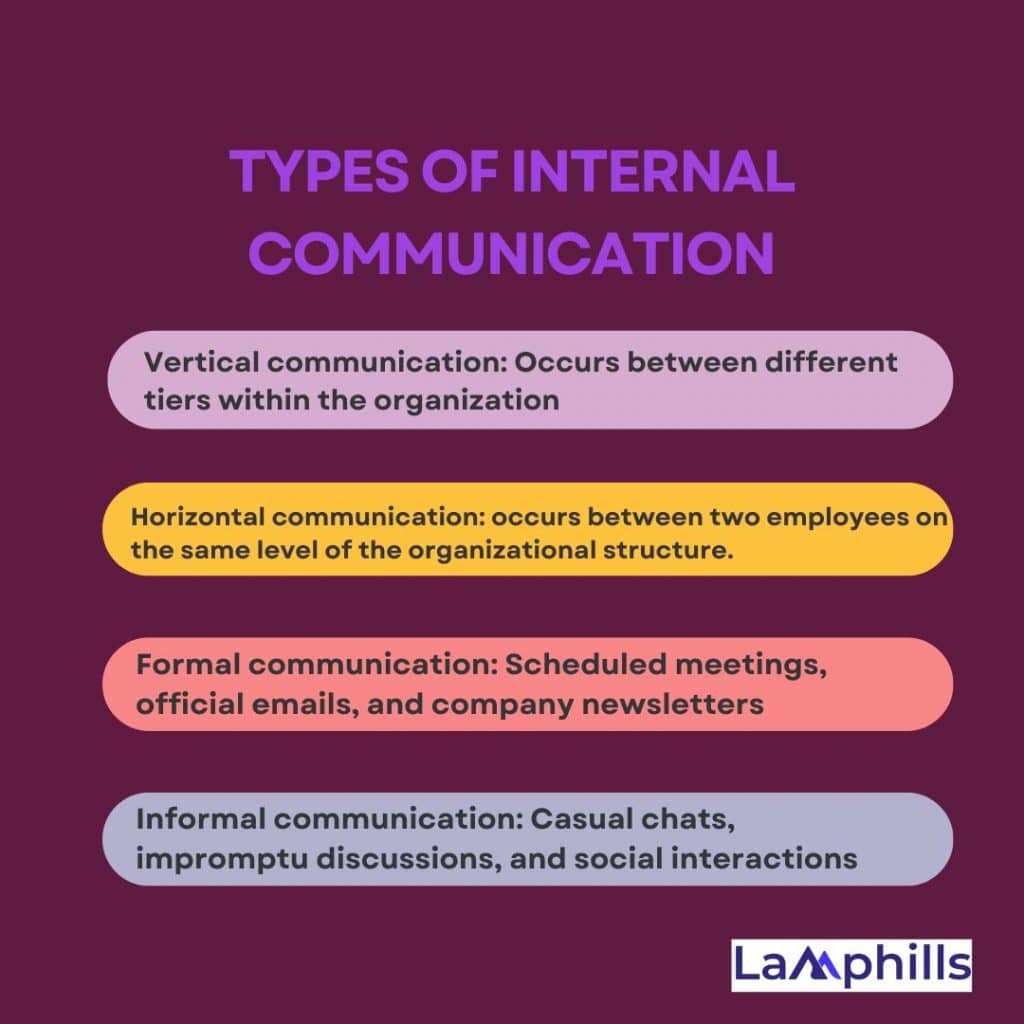If you have ever lost a key client because of miscommunication, then you’ll understand how important internal communication can be. I once worked with a team on a product that would serve as a marketplace for bloggers and advertisers. Along the line, a particular update was delayed because the development team was not aware of a change in the client’s requirements. Long story short, I almost lost that client if not for timely intervention. Poor internal communication can have adverse effects on your business, including wasted efforts and resources. If done right, on the other hand, it could be just the click you need to set everything up.
Key Points
- Internal communication is the exchange of information within an organization. It encompasses everything from formal announcements in company-wide emails to the casual water-cooler conversations that build relationships.
- Internal communication can be vertical, horizontal, formal, informal, or digital.
- Internal communication helps improve employee engagement, informs better decision-making, enhances collaboration, drives action, helps in crises management, and promotes the brand.
Understanding Internal Communication
Internal communication is the exchange of information within an organization. Just as a business addresses clients and potential customers with external communication, internal communication includes a discussion with those within the company and serves many important purposes. Internal communication encompasses everything from formal announcements in company-wide emails to the casual water-cooler conversations that build relationships. Understanding the different types of internal communication can help us manage and improve it effectively:

Vertical communication
Vertical communication takes place when staff members from different organizational tiers communicate. This can occur in structured settings, such as internal memos or organized staff meetings, or more casually in a conversation between a manager and an employee working within their department. For the higher-ranking staff members, vertical communication is an opportunity to give staff members instruction and help them better understand what the company expects from them. Vertical communication also allows employees to discuss their wants and needs with senior staff. This helps maintain company morale by allowing employees to see that upper management is listening to them and keeps communication open so that senior staff understands how to best manage employees in their department.
Horizontal communication
The most common form of communication in most offices is horizontal, occurring between two employees on the same level of the organizational structure. When two staff members assigned to the same project discuss how to share the workload, they engage in horizontal communication. Effective horizontal communication within a company is essential. Alongside allowing employees to perform better, it’s also crucial in team building and creating a strong social dynamic.
Formal Communication
This includes scheduled meetings, official emails, and company newsletters. These channels are essential for sharing important information and maintaining organizational structure.
Informal Communication
Casual chats, impromptu discussions, and social interactions fall into this category. While informal, these exchanges are crucial for building connections and fostering a positive work environment.
Digital Communication
Nowadays, tools like intranets, chat applications, and video conferencing platforms have become indispensable. These tools help bridge physical distances and keep everyone connected.
Why Is Internal Communication Important for Your Business?
Reflecting on my career, I’ve witnessed firsthand how effective internal communication can transform an organization. Here are some key benefits:

#1. Improved Employee Engagement
When employees are well-informed and feel heard, their engagement levels soar. I’ve seen teams become more motivated and productive simply because they understood the company’s goals and their role in achieving them. For instance, at one company, we implemented a monthly town hall where employees could ask questions directly to the CEO. This transparency significantly boosted morale and trust.
#2. Enhanced Collaboration
Good communication is the foundation of effective teamwork. I recall a project where we used collaboration tools like Slack and Trello. The ease of sharing updates and feedback in real-time led to a more cohesive effort and timely completion of tasks.
#3. Better Decision Making
Transparent communication ensures that everyone has the necessary information to make informed decisions. At one point, we introduced a feedback loop where employees could share their insights on strategic decisions. This inclusion not only improved the quality of our decisions but also fostered a sense of ownership and accountability.
#4. Drives action
Internal communication promotes both internal and external action. In the example I gave earlier, if the communications officer clearly informed the developers about the change in the client’s requirements, they would have effected the changes immediately and afford the client a seamless experience. Internal communication can authorize people to go ahead with a task, ask them to communicate with suppliers or collect opinions via the number of likes for a new product on an intranet page. It can take seconds to communicate a piece of information clearly and effectively.
#5. Helps in crisis management
Internal communication is a very valuable tool for managing crises. It can alleviate rumours and prevent negative situations within the organization. This can also feed through to external communication, as an organization’s reputation can easily be damaged by rumours that aren’t true.
#6. Allows for change
Strong internal communication is very important for staying ahead in today’s fast-moving and competitive business environment. It allows businesses to respond swiftly to climatic, environmental, and unexpected situations. For example, a retail chain I managed had to quickly match a competitor’s price drop on fruit drinks. Thanks to our robust internal communication system, we coordinated a state-wide price change within minutes, retaining customer loyalty and avoiding significant losses.
#7. Promotes the brand
A study by Gartner Communications shows that “Employees who feel well-informed become a company’s most credible ambassadors externally, while they may become its fiercest critics if they do not.” I couldn’t agree more.
Positive external communication is the key to strengthening an organization’s reputation. Employees become ambassadors when they talk about the company and share information through social media and other platforms; this can only be impactful when there is effective internal communication that encourages employees to participate online.
Challenges in Internal Communication
Despite its importance, internal communication often faces significant barriers:
Physical Barriers: With the rise of remote work, maintaining seamless communication has become more challenging. Dispersed teams can feel disconnected, leading to miscommunications.
Psychological Barriers: Sometimes, employees hesitate to voice their opinions due to fear of retribution or misunderstandings.
Technological Barriers: The lack of proper tools or the complexity of existing ones can impede effective communication.
To overcome these challenges, I’ve found it helpful to implement the following strategies:
Bridging Physical Gaps: Regular video meetings and virtual team-building activities can help maintain a sense of connection.
Addressing Psychological Barriers: Creating a culture of openness, where feedback is encouraged and valued, is crucial. Anonymized feedback tools can also help employees share their thoughts without fear.
Investing in Technology: Providing training and selecting user-friendly communication tools can significantly enhance communication efficiency.
Strategies for Effective Internal Communication
Over the years, I’ve developed several strategies to foster effective internal communication:
#1. Establish Clear Communication Channels
It’s important to define and maintain clear communication pathways. For instance, using Slack for quick updates, email for formal communication, and an intranet for company-wide announcements can streamline information flow.
#2. Encourage Open and Honest Feedback
Building a culture of transparency requires consistent effort. At one company, we implemented a bi-weekly feedback session where employees could voice their concerns and suggestions. This initiative not only improved processes but also made employees feel valued.
#3. Regular Updates and Meetings
Balancing the frequency and relevance of meetings is key. I’ve found that weekly team check-ins and monthly all-hands meetings keep everyone aligned without causing meeting fatigue.
#4. Use of Technology
Leveraging digital tools can enhance communication efficiency. Tools like Microsoft Teams and Zoom have been game-changers in ensuring that communication remains seamless, especially in remote settings.
Role of Leadership in Internal Communication

Leadership plays a pivotal role in shaping the internal communication landscape:
Leading by Example
Leaders must model effective communication practices. I know a CEO who always took the time to explain the rationale behind major decisions. His transparency and approachability set the tone for the entire organization.
Building a Communication Strategy
A comprehensive internal communication strategy is essential. This includes defining the goals, selecting appropriate channels, and setting clear expectations. At one company, we developed a strategy that included regular updates, feedback mechanisms, and training programs. This structured approach significantly improved our internal communication.
Here are some tips on building a successful internal communication strategy:
#1. Review your current internal communication methods
The method you use for internal communication can be one of the reasons you’re not driving results, and the best way to understand what needs to be done is by asking the staff. If your staff is not comfortable with the method you use, then it’s time to try another method. By finding out what their pain points are and what could be better, you’ll be embracing the importance of internal communication.
Working groups, staff surveys, and focus groups are a productive way to find out what people think. When selecting members for focus groups, make sure you’re choosing a diverse group of employees. For example, you’ll want to choose members of leadership and management, members of the sales team, technical teams, as well as members who are not desk workers, but more often on the frontlines. Surveys and focus groups don’t have to be long and complicated, often less than 5 questions is best.
#2. Analyze the results
Once you have employee feedback, it’s time to determine what needs to improve and how. Here are some questions you should ask:
- Does everyone in the target audience have access to the information they need?
- Do some staff receive information they don´t need?
- Is there a recurring problem e.g. lack of information, not enough contact from management, people feeling undervalued, communication not clear, poor employee engagement, distractions from unnecessary communications?
- Does the business need to improve transparency? Do people feel they are not kept informed of what they need to know to be part of the overall success of the company?
- Are there days of the week, or particular times of the year, when communications seem better, or worse?
- Did you feel adequately prepared to handle recent company events or announcements?
- What kind of feedback do you get from colleagues and peers on the internal comms at this company?
The answers to these questions will help you define the strategy to improve internal communication and what collaboration tools will bring benefits. You can then set goals using the SMART formula:
- Specific – do certain departments need specific communication methods? For example, does the Sales team need communication in Slack instead of email?
- Measurable – how will the changes be analyzed? On a quarterly basis, or a different metric?
- Attainable – are the suggested changes feasible?
- Relevant – are the goals appropriate to the target audience?
- Time – how long will it take to make the changes?
#3. Review the use of technology
Take stock of the current tools you use for sending internal communications. If your business would benefit from better communication tools, you should consider that. When choosing the technology to use, consider those that:
- Keeps everyone in a group informed
- Allows for adequate communication planning and tracking
- Offers social capabilities to encourage employee interaction and engagement
- Is easy to use – additional technology should never create more barriers to entry!
Many different tools can be integrated into an intranet to make communication easier. If groups of employees are already using certain tools, like Sales using Slack, HR using Google Drive, and your IT team using Microsoft Planner, make sure you’re investing in an intranet that can also integrate with and leverage these powerful tools.
#4. Set a budget and timelines
The budget available will influence how far things can change. We all know, you can only make the decisions that your budget allows for! For example, your business may require a completely new intranet, or parts of the existing intranet may only need updates, such as adding a social network, a mobile application, or an integrated search solution. Timelines should also be set to ensure the changes take place on time. Are there other projects that this might be contingent upon? And what about available staffing? These should all be considered.
You also need to inform employees about what’s happening so they can be part of the new internal communication strategy. You’ve listened to their opinions so now it’s time to put the new communication channels in place.
#5. Review and Improve
For an internal communication strategy to be successful it should be regularly reviewed. It should have short and long-term goals to measure its success. One thing you should look out for is social advocacy. If staff are liking and sharing messages you’re communicating to them then the formula is working.
Not everything will work. Give the changes time, and if they’re not successful then make changes. Improved communication strategy is a rolling program that will grow with the business.
Here’s a detailed checklist for your reference:
Measuring the Effectiveness of Internal Communication
To ensure that our communication efforts are effective, it’s important to track key metrics:
Employee Engagement Surveys: Regular surveys can provide insights into how employees feel about communication within the organization.
Feedback and Suggestion Rates: Tracking the volume and nature of feedback can indicate how open and effective the communication channels are.
Communication Tool Usage Statistics: Monitoring the usage of communication tools can highlight areas for improvement and training needs.
Continuous improvement is crucial. Regularly assessing the effectiveness of communication strategies and making data-driven adjustments can lead to significant enhancements.
What Is Internal and External Communications?
Internal communication is the exchange of information within an organization, including emails, meetings, and casual conversations, to coordinate activities and build relationships. External communication involves interactions with clients, partners, and the public to promote and manage the company’s image.
Conclusion
In conclusion, my experiences have taught me that effective internal communication is essential for business success. It improves employee engagement, enhances collaboration, and leads to better decision-making. By understanding the challenges and implementing robust strategies, businesses can create a culture of open and effective communication. I encourage all business leaders to evaluate their internal communication practices and make necessary improvements. After all, strong internal communication is the foundation upon which successful organizations are built.
Related Articles
- 8+ Communications Skills Every Specialist Needs to Thrive in 2024
- Is Communications a Good Major? All You Need To Know
- Public Communication Tips You Should Know in 2024
- The Top 10 Communication Agencies in Nigeria You Should Know






